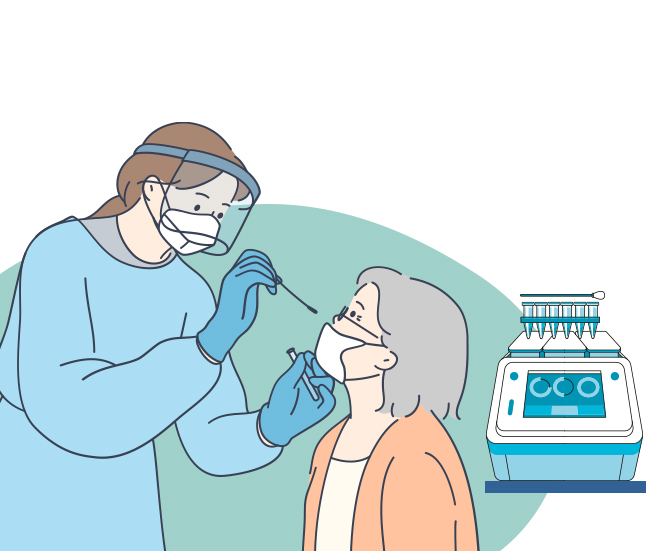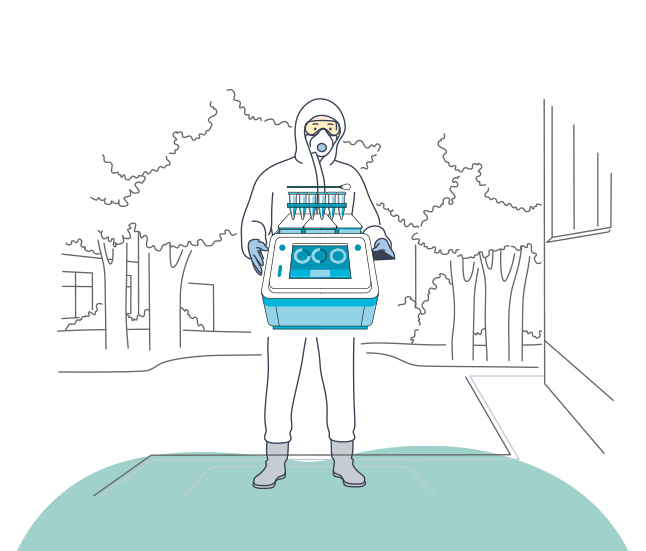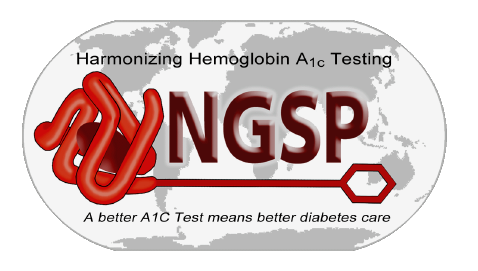Paneles de BiofireⓇ FilmArrayⓇ
BiofireⓇ FilmArrayⓇ panels for molecular diagnosis of acute respiratory infections
By: Jairo A. Mesa Arango*, Natalia Loaiza Diaz** * Molecular Laboratory Scientist, PhDc in biology, Laboratorio Clínico Hematológico S.A. Medellín, Colombia. ** Chief of Clinical Pathology, Medical Specialist in Microbiology, Laboratorio Clínico Hematológico S.A. Medellín, Colombia. Published on 27-05-2021
Diagnosis of respiratory infections in the clinical laboratory
Traditional diagnosis:
Microbiological diagnosis of respiratory infections caused by bacteria, fungi, viruses and parasites has traditionally focused on direct microscopic visualization and culture of the microorganisms present in respiratory samples. In this way, their isolation and identification is achieved through the study of phenotypic and biochemical characteristics, and the range of susceptibility to antimicrobials, which allow the diagnosis to be established and timely clinical and pharmacological management to be carried out.
Traditional methodologies can be complemented with serological tests that directly or indirectly detect antigens of the microorganism under study, or antibodies against it, present in blood, serum or body fluid samples. This type of test is especially relevant in cases of infections caused by viruses, which are difficult to detect due to their small size (which makes microscopic visualization difficult) and their complexity for handling by culture techniques.

Traditional microbiological procedures continue to be the methods of choice for routine laboratory diagnosis, as they are cost-effective and cover the diagnosis of a significant number of infections caused by pathogenic agents or microorganisms. However, they present multiple limitations such as the execution of laborious protocols and extensive workflows (24-48 hours on average, and even days), limited performance (sensitivity/specificity), limited application in the study of microorganisms that cannot be cultured by conventional methods, and the difficulty of achieving a definitive diagnosis. The above, added to the variations that can be induced due to the technique used, the type of sample, the pathogen sought and its concentration in the sample. In addition, their detection capacity is limited to one or at most two types of pathogens simultaneously.
Molecular diagnosis:
Molecular techniques have revolutionized the way infections are diagnosed, as they allow the simultaneous detection of different species of microorganisms in the same assay (single or polymicrobial infections) and the massive study of samples. Molecular tests can be applied directly to clinical samples from patients for the detection of the nucleic acids (DNA/RNA) present, from which taxonomic identification (genus, species and subspecies or variants of the microorganism) and molecular characterization of the agent(s) involved for diagnostic purposes is possible.
Currently, techniques based on molecular biology allow cost-effective diagnoses, with greater sensitivity and specificity, and less expensive than traditional microbiological tests. Molecular diagnostic tests, in addition to favoring rapid typing of non-culturable pathogenic microorganisms, make it possible to quantify the microorganisms identified and detect genes associated with antimicrobial resistance in a matter of hours, which significantly reduces the time it takes to obtain results (8-12 hours on average) and facilitates the management and timely treatment of infections by medical personnel.

The BiofireⓇ FilmArrayⓇ Respiratory Panel (RP2.1) is designed to detect and differentiate the genetic material (DNA or RNA) of 22 microorganisms, 18 viruses and 4 bacteria causing respiratory infections, including RNA of the Coronavirus causing severe acute respiratory syndrome type 2 (SARS-CoV-2). Other respiratory viruses detected in the panel are: Adenovirus, Coronavirus 229E, Coronavirus HKU1, Coronavirus NL63, Coronavirus OC43, Human Metapneumovirus, Human Rhinovirus/Enterovirus, Influenza A including subtypes H1, H3 and H1-2009, Influenza B, Parainfluenza virus 1, Parainfluenza virus 2, Parainfluenza virus 3, Parainfluenza virus 4, Respiratory syncytial virus. The bacteria included are: Bordetella parapertussis, Bordetella pertussis, Chlamydia pneumoniae and Mycoplasma pneumoniae.
Nucleic acids of these infectious agents are detectable in nasopharyngeal swab samples from individuals with signs and symptoms of respiratory infection during the acute phase of the disease. A positive result on the respiratory panel indicates the presence of the microorganism whose genetic material was detected and supports the diagnosis and treatment of respiratory infection when correlated with clinical and epidemiological findings. However, the detection of a microorganism in this panel does not rule out co-infection with other pathogens that are not included in this panel. Negative results may be due to RNA or DNA of the causative agent being below the detection limit of the test, to the pathogen not being part of the microorganisms evaluated in the panel, to problems in the pre-analytical phase, to the use of respiratory samples not validated for the RP2.1 panel, among others.
**In the Clinical Hematology Laboratory we have available the RP2.1 BiofireⓇ FilmArrayⓇ respiratory panel:
- It allows the simultaneous detection of the genetic material (DNA/RNA) of 22 microorganisms (18 viruses and 4 bacteria) causing acute respiratory infection (including SARS-CoV-2 virus), by means of real-time multiplex RT-PCR. The detected agents are identified to genus and species level.
The use of this panel for the detection of SARS-CoV-2 virus is endorsed by the National Institute of Health (INS), according to the guidelines of the Ministry of Health and Social Protection of the country.
2. It has an overall sensitivity and specificity of 97.6% and 99.8% for RT-PCR.
3. Provides results in less than two (2) hours.
4. The required sample is easy to collect: nasopharyngeal swab taken by one of our bacteriologists, in any of our offices or at home.
NOTE: If you have respiratory symptoms or symptoms suggestive of COVID-19, we recommend that you request the home sampling service: https://lch.co/domicilios/
5. SARS-CoV-2 screening test (COVID-19) valid for domestic and international travelers, taking into account the required validity according to the country of destination. Delivery of result in English, if required.
6. Consultation of electronic results through our Web portal https://resultados.lch.com.co/ or delivery of printed results in any of our offices.

Bibliografía
- Instituto Nacional de Salud (INS). Protocolo de vigilancia en salud pública. Infección Respiratoria Aguda (IRA). Códigos: 345, 348, 591,995. 2020;17-17.
- Lee VJ, Ho ZJM, Goh EH, Campbell H, Cohen C, Cozza V, et al. Advances in measuring influenza burden of disease. Influenza Other Respir Viruses. 2018;12(1):3-9.
- World Health Organization. COVID-19 Weekly Epidemiological Update 22. World Health Organ. 2020;(December):1-3.
- Chapin K. Multiplex PCR for detection of respiratory viruses: Can the laboratory performing a respiratory viral panel (RVP) assay trigger better patient care and clinical outcomes? Clin Biochem. 2011;44(7):496-7.
- Pettit NN, Matushek S, Charnot-Katsikas A, Tesic V, Boonlayangoor S, Brielmaier B, et al. Comparison of turnaround time and time to oseltamivir discontinuation between two respiratory viral panel testing methodologies. J Med Microbiol. 2015;64(3):312-3.
- Schull MJ, Mamdani MM, Fang J. Influenza and Emergency Department Utilization by Elders. Acad Emerg Med. abril de 2005;12(4):338-44.
- Xu M, Qin X, Astion ML, Rutledge JC, Simpson J, Jerome KR, et al. Implementation of FilmArray respiratory viral panel in a core laboratory improves testing turnaround time and patient care. Am J Clin Pathol. 2013;139(1):118-23.
- Locher K, Roscoe D, Jassem A, Wong T, Hoang LMN, Charles M, et al. FilmArray respiratory panel assay: An effective method for detecting viral and atypical bacterial pathogens in bronchoscopy specimens. Diagn Microbiol Infect Dis. 2019;95(4):114880-114880.
- Vira H, Bhat V, Chavan P. Diagnostic Molecular Microbiology and its applications: Current and Future Perspectives. Clin Microbiol Infect Dis. 2016;1(1):20-31.
- Buchan BW, Ledeboer NA. Emerging technologies for the clinical microbiology laboratory. Clin Microbiol Rev. 2014;27(4):783-822.
- BioFire Diagnostics. BioFire® Panel respiratorio 2.1 (RP2.1). 2020;1:1-62.
- Hanson KE, Azar MM, Banerjee R, Chou A, Colgrove RC, Ginocchio CC, et al. Molecular testing for acute respiratory tract infections: Clinical and diagnostic recommendations from the IDSA’s diagnostics committee. Clin Infect Dis. 2020;71(10):2744-51.
- Marimón JM, Navarro-Marí JM. Métodos de diagnóstico rápido de las infecciones respiratorias. 2017;35(2):108-15.



